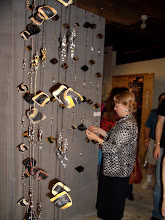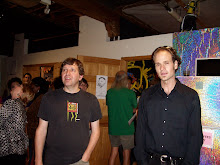enter the treadknot
Welcome
On September 26th, 2006, I launched my tire art/design business, Reptire Designs, with a solo exhibition of my artwork in The Green Gallery at The Scrap Exchange Center for Creative Reuse, in Durham, NC. For many reasons, it was a night that I will always remember, and I am grateful to Laxmi (my girlfriend at the time) and Edie (my mother, still) for dutifully documenting while I shmoozed, so that I may now shmare a taste of the evening with anyone who was not able to attend...
On a cool but lively autumn night-before-Center Fest, a stream of friends and curious strangers trickled (like pebbles through a rain stick) through the forest of odds and ends (that roost at night in The Scrap Exchange), out into the warm light of the back savanna, a scene utterly glopped with bizarre rubbery hybrids. Tentative and curious, the visitors craned their necks, nibbled, pecked, stood back, moved in closer. From the walls, glassy mirror eyes gazed back through black unblinking eyelids, while beneath the visitor's feet, in a steamy drainage cistern, a mortal drama unfolded. Primordial forms, with no eyes at all, sat puckered on stoops. A cascade of glittering steal droplets formed a curtain, to which clung a colony of tiny tire knotlettes.
By the end of the night, hundreds of friends, acquaintances and had-been-strangers had poured in, poured over the work, and partaken in, what was for me and my art, a monumental communal feast. And on top of it all, I got to place many of my preemies in hands that I love and trust, and in several instances, hands that fit them like gloves. What a privilage to be able to connect with people this way. Heading into the turbid seas of small business, I can confidently say that if I drown tomorrow, I am at least blessed today with the memory of (as Vito later put it) one authentically good Durham night.
Thanks to all of you who were there; in body and/or spirit.
On September 26th, 2006, I launched my tire art/design business, Reptire Designs, with a solo exhibition of my artwork in The Green Gallery at The Scrap Exchange Center for Creative Reuse, in Durham, NC. For many reasons, it was a night that I will always remember, and I am grateful to Laxmi (my girlfriend at the time) and Edie (my mother, still) for dutifully documenting while I shmoozed, so that I may now shmare a taste of the evening with anyone who was not able to attend...
On a cool but lively autumn night-before-Center Fest, a stream of friends and curious strangers trickled (like pebbles through a rain stick) through the forest of odds and ends (that roost at night in The Scrap Exchange), out into the warm light of the back savanna, a scene utterly glopped with bizarre rubbery hybrids. Tentative and curious, the visitors craned their necks, nibbled, pecked, stood back, moved in closer. From the walls, glassy mirror eyes gazed back through black unblinking eyelids, while beneath the visitor's feet, in a steamy drainage cistern, a mortal drama unfolded. Primordial forms, with no eyes at all, sat puckered on stoops. A cascade of glittering steal droplets formed a curtain, to which clung a colony of tiny tire knotlettes.
Vito D., a long-time collabator down from the Asheville area, caressed the warming air with his Strange Little Folk music. I bobbed and I flit, and at an increasing clip-someone must have opened the faucet a bit....for soon I was swooning, I just about lost it! As the evening progressed, to my delight and amazement, 'family' from Durham, Chapel Hill, Pittsboro, Hillsboro, Siler City, Asheville, and Fresno all made it! From the Cohn Clan to the Steudel Clan to the CFS Clan; from the WWC Clan to the Duke Ac Pub Clan to the SAF Clan; from the Bike Shop Clan to the Ninth St. Clan to the Scrap Clan... and every one in between, guys, they were all appearing before my stunned, blinking eyes. While I spun and I splayed, Vito now played-CHURNED- up a torrent of gritty ditties; while a staff volunteer (Brandon's a photographer, I swear) whipped up pitchers of Mango Lassies. And The 'Scrap Exchange girls' worked the door, the counter, and the floor, going "cha-CHING!", cha-CHING!","cha-CHING!".!.
By the end of the night, hundreds of friends, acquaintances and had-been-strangers had poured in, poured over the work, and partaken in, what was for me and my art, a monumental communal feast. And on top of it all, I got to place many of my preemies in hands that I love and trust, and in several instances, hands that fit them like gloves. What a privilage to be able to connect with people this way. Heading into the turbid seas of small business, I can confidently say that if I drown tomorrow, I am at least blessed today with the memory of (as Vito later put it) one authentically good Durham night.
Thanks to all of you who were there; in body and/or spirit.
Reclaimed-wood Builder and Reptire Collector Howard Staab enjoying magwi knot at the Scrap Exchange
I can't think of anything more rewarding for an artist than to see someone interacting with their artwork. Photo by Laxmi Haynes
Sammy and Dannette contemplate
Photograph by Laxmi Haynes
Cascade Colony of Knotlets

They would go with your jacket, would they not Claire?
Laxmi Resplendent

Mavis In The Mist
Photograph by Laxmi Haynes
Tire Amazement

Photograph by Edie Cohn
Monday, June 10, 2013
The Story Of Craft
In the course of a long and sordid one-last-night-in-Dublin,
I chanced upon a used bookstore in a storefront basement, and there I gleaned a
few really choice books to tide me through the next 16 hours of ‘airport
living’ (which I was right burnt out on, and happy to escape, by any such means
I could find, at that late point in my adventure).
One little gem that I picked up there was a medium sized
hardcover book entitled “The Story Of Craft (The Craftsman’s Role In Society)”,
by “the well known poet and art critic” Edward Lucie-Smith.
Well,
I’ve never heard of old Edward either, but I tell you what, the guy really
knows his stuff! This book turned out to be every bit as fascinating as I’d
hoped, and to my surprise, even more relevant!
Lucie
begins with an ambitious and far reaching survey of crafts people and
traditions in different cultures around the world, through out human history.
While I am a little bit wary of such sweeping generalization, which he conducts
in a typically blaze and confident Brittish manner, he draws some interesting
conclusions from this survey…
I
have to admit, I was a little bit surprised and disturbed by his first
observation (though Lucie-Smith would not be in the least disturbed or
surprised that I was disturbed and surprised, as you shall see…)
And that observation is that craftsmen have been, as a rule,
feared and despised in most cultures and societies through out history! An
example of this would be the black smith in African cultures, who was seen to
have magical powers. In other (mostly agrarian) cultures, to toil with one’s
hands was looked down upon.
This
observation sets the groundwork for Lucie’s over-arching point, which he rails
on through out the book, namely to debunk the romantic myths and ideals of the
craftsman that the Arts and Crafts movements held, and hold so dear. A little
bit cynical and even mean spirited, but none the less, a point well worth
examining!
The
most interesting point that Lucie draws from in his sweeping survey of all the
major cultures of human history, is to identify Japanese culture as perhaps the
one culture that stands out as valuing craft, more than any other. And it here, to Japanese culture, that
Lucie deftly traces back the roots of our modern ideal of the craftsman.
However,
even while doing so, he aptly points out that Asian craftspeople were quick to
cater their crafts to the tastes of European buyers, even then. The irony that
this was as true then as it is now lends some credence to the greater guist of
Lucie’s argument.
And
this brings us to Lucie’s larger point, and this is really the guist of his
argument. Lucie argues mainly to dubunk the myth that industry and crafts are
at odds (an contention which he shows has arisen repeatedly, and in his mind,
tiresomely, over he past several hundred years)
His
point, and he argues it pretty convincingly, is that industry has always been a
part and parcel of craft. Craft has always been about the work of mass
producing items for daily use, and also of finding easier ways to do these
tasks!..
He
sites the (dis)assembly line schemes in Cleveland slaughterhouses as the origin
of mechanization. I don’t know if I would go that far, but interesting analogy.
He ends off with the field of industrial design.
CONCLUSION
On the whole, true to its subtitle, this is a really
fascinating look at the place of crafts production in human society. And I
think this book bears a whole lot of relevance to our modern times (the book
was published in 1981).
Which leads me to wonder, what are the implications of this
book 30 years after it was published, to the second decade of the 21st
century?
In an age of
increased globalization? Where the Chinese have progressed from creating
netsuke to cater to European tastes, to manufacturing any cheap thing the outer
world might ask for, to creating laptop screens, and finally, even mass
producing fake Amish quilts!..
Where have we gone since Lucie published this book?
Was he right?
And what are
the implication of this progression for Reptire Designs?


